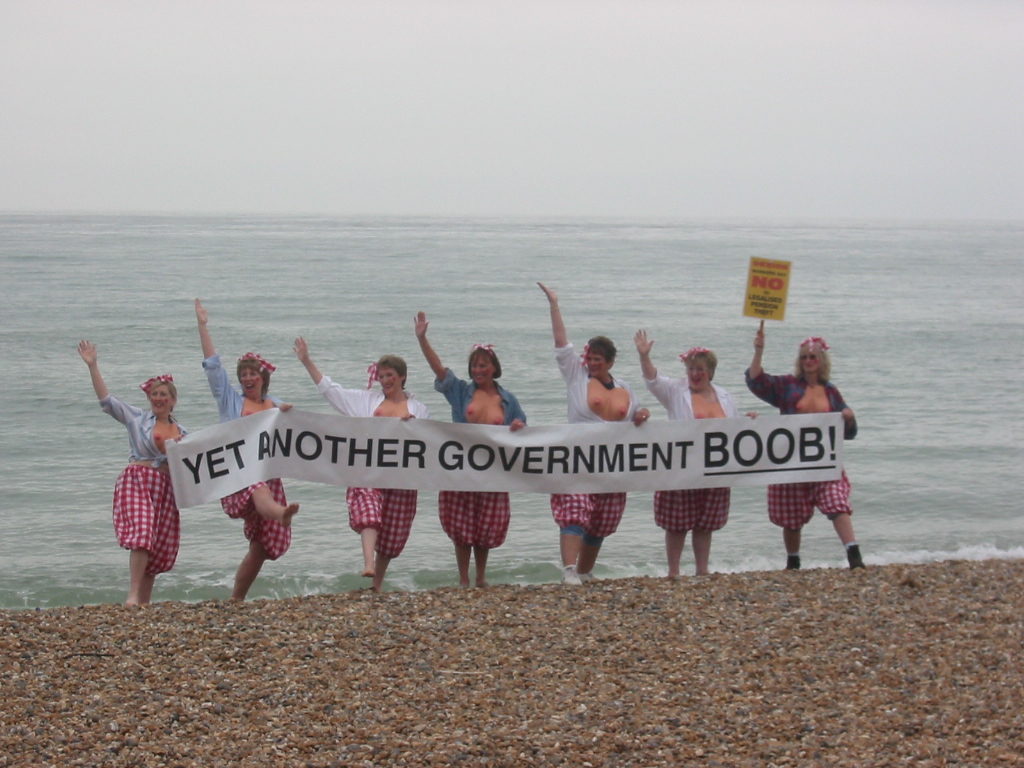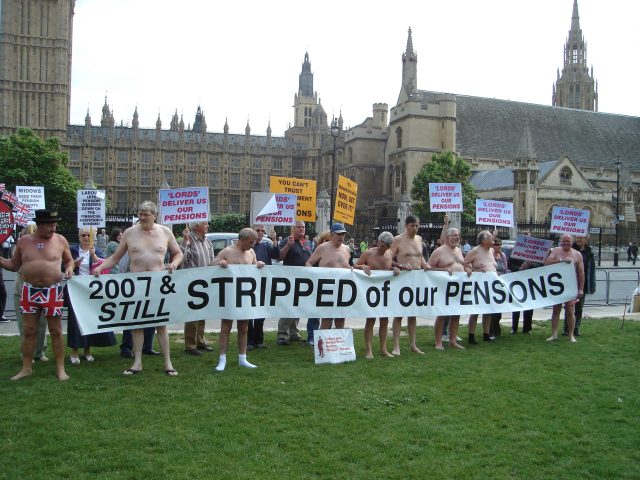
TARBELL COLUMN
-+=+-
Last Saturday night, in a town just outside London, fifty or so pensioners got together to share a few drinks, nibble on buffet food and enjoy some good company. They played bingo, held a pub quiz and talked of times gone by.
Having travelled from across the UK, they spoke in a variety of accents – from lilting Welsh to chirpy East London cockney, from singsong Brummie to Scottish burr. Once skilled and semi-skilled manual workers, many of those who came had spent decades working in steel mills, manufacturing, printing and other traditional industries.
These were ordinary folk, then. Their shared experience, though, and the story behind their close affinity and fellowship, was anything but ordinary. The hall in which they gathered was festooned with large demonstration banners and large posters, along with photographs of them, in various forms of fancy dress, parading outside Parliament, HM Treasury and other government buildings.
For those who met at the Leverstock Green Cricket Club in Hemel Hempstead last Saturday night were key members of the Pensions Action Group (PAG). And between them, they masterminded one of the most focused, audacious – and highly effective – single-issue grass roots campaigns in modern British political history.
I was delighted to join them and privileged, earlier in my journalistic career, to have played a small role in their astonishing success. This was an evening that reminded me of the importance of democracy, the efficacy of collective action and the ability of individuals and the media, if they try really hard, to hold politicians to account. An otherwise enjoyable evening, though, also raised concerns in my mind, giving me considerable pause for thought.
During the early 2000s, numerous UK company-based ‘occupational’ pension schemes started to get into serious final difficulties. The reasons were many and varied – including rising life expectancies, volatile stock markets and a tax rise in the late-1990s, introduced by then Chancellor Gordon Brown. By placing additional levies on reinvested dividends, Brown’s disastrous ‘pensions stealth tax’ cost company pension schemes many billions of pounds annually, losses which were magnified when compounded over many years.
Once the first few ‘final salary’ occupational schemes began to close – a phenomenon I reported in detail on both Channel Four News and in The Telegraph – dozens more followed. These failures were an enormous shock. Final salary schemes were seen by UK workers as the ‘gold standard’ of pension provision, linked as they were both to wages on retirement and length of service. For decades, employees had assumed such pensions were safe – seeing as they were backed by years of employee and employer contributions. Successive governments, moreover, wanting to encourage workers to save for their retirement, regularly published leaflets stating that, whatever happened to any particular firm, final salary pensions were “guaranteed”.

As these schemes began to fold, thousands of workers, having been advised they would receive a lump sum on retirement, then a healthy monthly pension for life over and above the basic state pension, faced the prospect of getting nothing. This was obviously devastating. As I reported on such occupational pension closures on television and in print, I received hundreds of letters and emails from distraught scheme members.
Under the law as it stood, as individual members of final salary schemes retired, their entitlement would be calculated and an annuity purchased, guaranteeing that income for the rest of their life. But when sponsoring companies started to go bankrupt, pension scheme members who had yet to retire – even if they had given 20, 30 or 40 years of service, making monthly contributions throughout – could end up with nothing.
Previously, as companies had collapsed or been sold, final salary schemes had generally been healthy enough to meet ongoing and future obligations from accumulated assets. Alternatively, new company owners would take on the pension scheme. But as life expectancies got longer, and the world became more competitive as a new millennium ushered in an age of globalisation, the finances of many UK pension schemes became hopelessly stretched. At the same time, lawyers used loopholes to help investors taking over flagging firms to renege on pension liabilities owed to those yet to retire – even if they were just a few years, or even months or weeks away from doing so and had made decades of contributions.
The PAG emerged from the ashes of this tragedy and injustice. This was a collection of traumatised employees, working for companies across the country, who had suddenly lost their entire future occupational pension, which they’d paid for from years of foregone wages. Rather than accepting what seemed inevitable, these individuals – none of whom had the remotest experience of politics or the media – formed a devastatingly effective campaigning unit.
At the heart of the group was Pete Humphreys, who had worked for shelf manufacturer Dexion for decades and was very close to retirement when its pension scheme went bust. It was Pete’s utter determination and commitment to restoring the pension of himself and his fellow workers, combined with the irrepressible sense of humour of his wife Jacquie, that set the tone.
As such, PAG’s relentless campaigning combined humour with a steely resolve and lashings of media savvy. The group used a long ‘Stripped of our Pensions’ banner, held by up to a dozen naked campaigners, their modesty covered only by the banner itself. It was an image that secured acres of newspaper coverage – so much so that PAG repeated the stunt at every Conservative and Labour party conference for years. Other demonstrations saw the ‘pensions theft’ victims dress up as gangsters, St George slaying his dragon, or Laurel and Hardy. The cause was desperate – not least as PAG members were using their diminishing savings to finance their demonstrating antics, which took them to many parts of the country. Some of those affected died without receiving any pension. A few became so distraught they committed suicide. But the media image was one of stoical determination, backed by remorseless logic and tempered with an eye-catching sense of black comedy.
While building a media presence, the PAG also sought and secured expert help – largely from volunteers. Chief among those was Ros Altmann, an experienced investment manager and pensions professional who was shocked by their plight. Altmann used her contacts and skill to help secure PAG legal opinions and a galaxy of helpful consultancy reports. When combined with the group’s growing media clout, such evidence meant the Humphreys and the growing ranks of the PAG couldn’t be dismissed by officialdom.
As a direct result of the PAG’s campaigning, the government set up the Pension Protection Fund in 2005. Funded by industry levies, it was designed to pay 90% of workers’ pensions if their occupational schemes went bust. Today, hundreds of thousands of present and future retirees are benefiting from, or stand to benefit, from the PPF.
Crucially, though, those who lost pension rights before the PPF was established – around 125,000, including much of the PAG – remained uncovered. There was much further protesting and legal and political grappling, including ever more ingenious protests, which eventually led to the government establishing the Financial Assistance Scheme (FAS) specifically for such retirees, initially setting aside £2bn of public money.
Before the FAS started working properly, though, paying out pension due, there were more battles to come. As entitled but still pension-less retirees died, there was much disgraceful foot-dragging by ministers and officials. A Parliamentary Ombudsman’s report found the ‘gross injustice’ highlighted by the PAG had resulted from ‘government maladministration’ and repeated instances of bad regulation.
PAG took its case to the European Court of Justice, which said ministers had acted in a manner that was ‘unlawful and inadequate’. And when a High Court Judge upheld the Parliamentary Ombudsman’s verdict, against which the government has astonishingly appealed, Chancellor Gordon Brown, in a surreal twist, ‘rejected’ that verdict too. At that point, PAG’s demonstrations, and their broader plight, became a major national news story, ultimately forcing the government to submit.
Last week’s PAG gathering in Hemel Hempstead was the tenth anniversary of the weekend when the Humphreys were telephoned by then Pensions Minister Mike O’Brien, who told them the government had finally agreed to fund and administer the FAS properly. PAG members talk warmly of O’Brien. He is one of few government figures who comes out of this sorry saga with any credit.
It was an uplifting gathering, as I said – attended also by Altmann, whose stellar work eventually saw her brought into government, and also Jeff Prestridge, the doyenne Mail on Sunday personal finance journalist, who also took up the PAG’s cause. There was much talk of self-help, determination, making your own luck and ‘beating the system’. I also reflected that this whole episode highlighted the overwhelming necessity, when capitalism throws up manifestly unfair outcomes, of appropriate government intervention.
Delighted to have met up with the PAG gang, though, reliving journalistic adventures past, I have nagging concerns on two fronts. The first is the fast diminishing will and ability of the contemporary media to commit the resources needed, both financial and intellectual, to sustain campaigns that tackle serious injustices – particularly when it comes to financial fraud.
Covering a story like ‘pension theft’ in depth, helping to ‘shift the dial’, was a legal and political minefield. It’s the kind of journalism that requires resilience, an eye on the long-term and the capacity within an organisation to get beyond the demands of daily news. Tackling complex yet hugely important stories relies on financial and editorial backing for the long-haul – which I was lucky (some of the time) to have, but which now seems painfully thin on the ground.
The second issue that troubles me is the more specific lack of pension provision. Three in ten Britons aged 55-64 have no pension savings, or savings that are entirely inadequate, according to a 2016 report for Scottish Widows. That rises to almost half of 30-40 year-olds. The UK has made great progress in tackling pensioner poverty over recent decades. But vast swathes of those currently in their 40s and 50s are heading towards retirement with no pension savings. Laboring under enormous mortgage debts due to bloated house prices, or unable to get on the property ladder and paying high rents, they find it almost impossible to put adequate money. As such, we could soon see a return in the UK to widespread pensioner poverty – which ever more people relying only on a basic state pension which, by international standards, remains rather low.
The workers who combined so heroically to form the PAG were able to fight for their pensions because, having made substantial contributions over many years, they had something to fight for. Increasingly few of their successors can claim the same.










Join the discussion
Join like minded readers that support our journalism by becoming a paid subscriber
To join the discussion in the comments, become a paid subscriber.
Join like minded readers that support our journalism, read unlimited articles and enjoy other subscriber-only benefits.
Subscribe